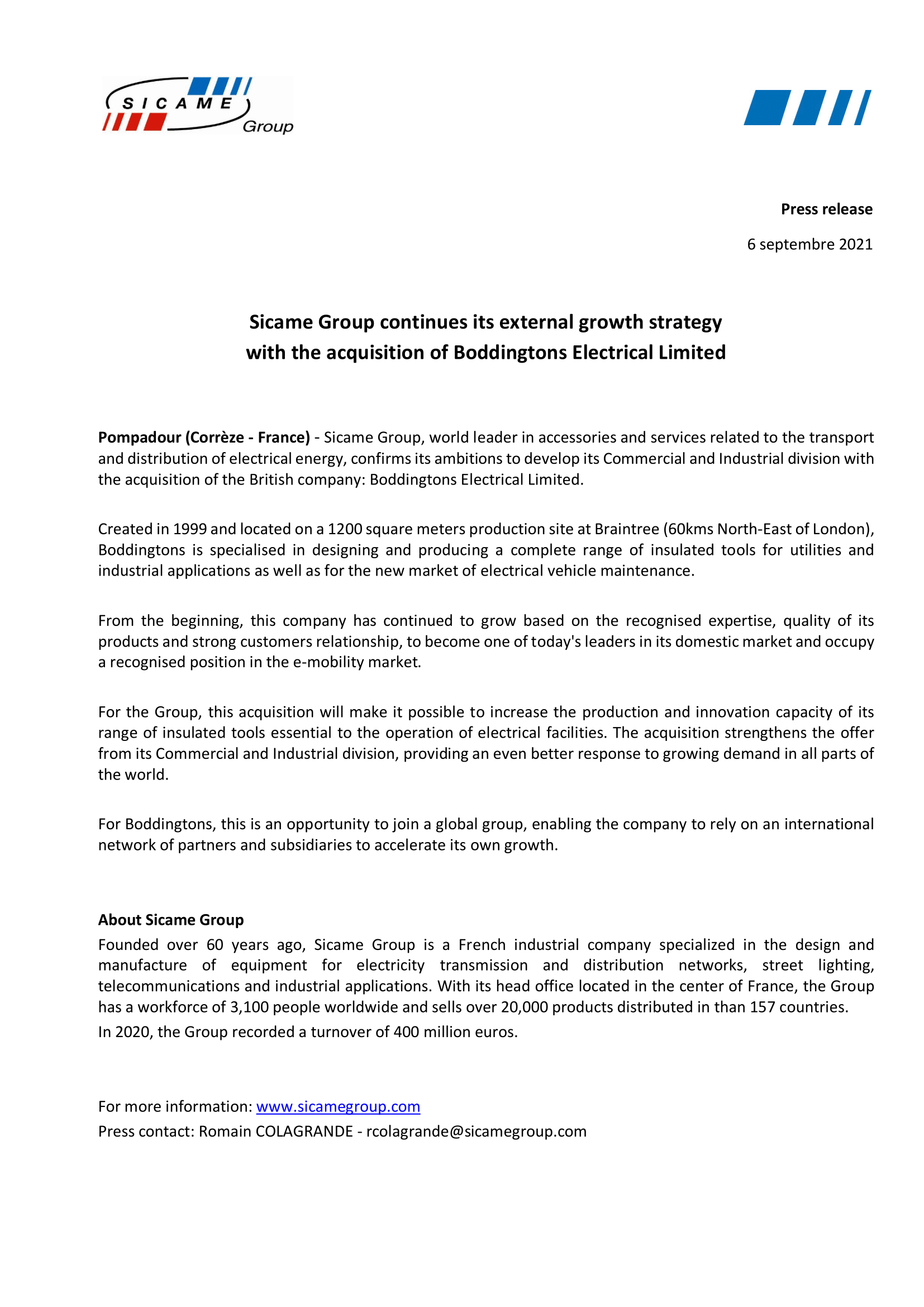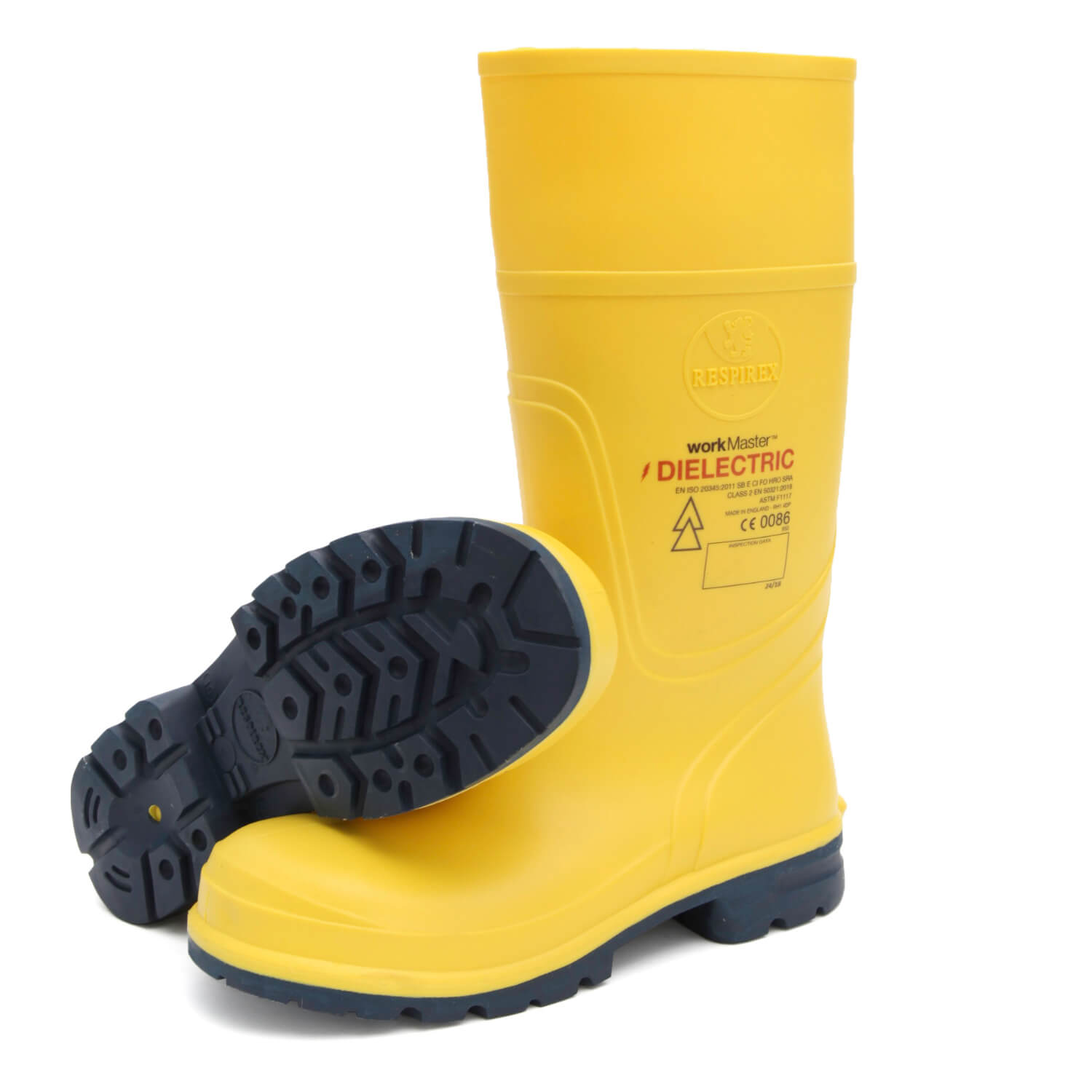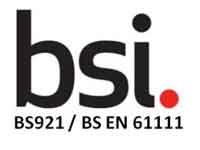Blog Category
Industry News

Please click on this press release regarding the recent acquisition of Boddingtons Electrical by the Sicame Group in France.
The Boddingtons Electrical brand will remain as will the UK manufacturing facility at our current site. Being part of the Sicame group will enable us to further grow our in-house production and also provide our customers with a greater range of safety products from the group.

EN 50321-1:2018 was harmonised and published earlier this year and replaces EN 50321:1999. This standard is currently out for approval as an IEC standard which will make it a global standard not just European.
The standard has been split into 3 parts.
Part 1 is for live working on complete insulated boots up to 36 KV working voltages.
Part 2 which is currently being drafted is for insulated soles for step voltages. And refers mainly to Leather Footwear that must be kept dry and is not intended for “Live working” and will not carry the Live working double triangle.in it CE marking.
Part 3 is for live working at voltages above 50 KV where the footwear must be conductive. The drafting of this standard has not started.
The main changes to part one are the introduction of 4 classes ( see below) for working up to 36 KV whilst the old standard only had working up to 1000 Volts ( 1 KV). Boots are now tested by filling with water this is because steel balls always gave lower results and did not take into account water or perspiration wicking up the lining creating a flashover. There is now an electrical test after perforation of the sole by a nail, to ensure boots still give electrical protection after perforation of the sole. Just because a perforation insert is non-metallic it does not imply it is electrically insulating most will allow water to pass through them so will allow an electrical current to pass when the sole is punctured. In the table below is listed the classes and the test requirements
Class | Maximum AC Working Voltage | Proof test Voltage | Proof test Leakage current | Withstand Test Voltage AC |
00 | 500 V | 2.5 KV | 3 m A | 5 KV |
0 | 1 KV | 5 KV | 5 m A (8 m A) | 10 KV |
1 | 7.5 KV | 10 KV | 10 mA (16 mA) | 20 KV |
2 | 17.5 KV | 20 KV | 18 m A (18 mA) | 30 KV |
3 | 26.5 KV | 30 KV | 20 m A | 40 KV |
4 | 36 KV | 40 KV | 24 m A | 50 KV |
In the table, we have included the requirements for Knee boots the Overboot requirements are in brackets where they are different from boots. The leakage current requirements for Overboots is slightly higher due to the larger surface area.
The new standard also includes requirements for DC. All boots used for DC must be tested for DC according to the new standard.

Electrical safety matting is a vital part of electrical safety and is typically used for protection around areas where high voltage (HV) equipment – such as a switchboard – is being used and worked upon, but it is also available for working on low and medium voltage (LV and MV) equipment.
Typical applications include when working in front of switchboards, machine control gear, in plant rooms and lift control gear rooms, and also as portable protection for site engineers working on live equipment.
BS EN 61111:2009 v BS 921:1976
BS 921:1976 was withdrawn because it conflicted with the now current UK national standard of electrical insulating matting, which is BS EN 61111:2009. Under the auspices of BS EN 61111:2009, the matting must withstand a greatly extended testing regime compared with the old BS 921:1976 standard.
Compliance with BS EN 61111:2009 means that the matting will have a number of benefits over the BS 921: 1976 variety, as it is oil and acid resistant, flame retardant, lighter in weight, and there are a various classes for different voltage applications.
It is believed that matting manufactured to the superseded BS 921: 1976 regulation is still available, as it is suitable for its originally intended use in the UK. Now, however, it is known as ‘Electrical Safety Matting’ tested to 650V working insulation.
Boddingtons Electrical now manufacturer IEC61111 insulating matting for electrical safety, protection and working on low, medium and high voltage substations and switchgear up to 33kV – the IEC61111 standard provides a selection category for Low Voltage (1000V) to High Voltage (36kV). The selection table below informs and explains the IEC standard classification according to the maximum working voltages for rubber insulating matting.
Working Voltage, Withstand Test & Proof Test Of Electrical Safety Matting
The withstand test of insulating matting for electrical insulation is applied to each manufacturing batch of switchboard matting to ensure it does not have an electrical breakdown if exposed to high voltages – the working and withstand voltages must not be confused.
The proof test of insulating matting are dielectrical resistance tests provided by the mat manufacturer on the total running metre of the product and are used to safeguard a standard conformity of resistance throughout the entire section, roll or surface area of the electrical mat – the proof test must be applied to the insulating mats for a set time at a specified voltage level.
Insulating rubber switchgear matting in accordance with IEC 61111 or BS EN 61111 can be used to prevent earth contact with the floor however the matting will not provide any electrical shock protection if a person touches metal areas of the switchboard or control panel simultaneously with exposed live conductors which are likely to be at earth potential and readily accessible.
| Class Of Insulating Matting According To IEC61111 | Proof Test | AC Maximum Working Voltage | Withstand Test Of Insulating Matting |
| Class 0 Matting | 5kV | 1000V – LV Low Voltage | 10kV |
| Class 1 Matting | 10kV | 7500V – MV Medium Voltage | 20kV |
| Class 2 Matting | 20kV | 17000V – MV Medium Voltage | 30kV |
| Class 3 Matting | 30kV | 26500V – MV Medium Voltage | 40kV |
| Class 4 Matting | 40kV | 36000V – HV High Voltage | 50kV |
The IEC61111 matting specification covers electrical insulation and performance criterion including:
- Mechanical Puncture Resistance
- Oil Resistance
- Acid Resistance
- Slip Resistance
- Flame Retardancy
- Ageing
- Marking Durability
IEC 61111 Has Replaced BS921 Electrical Rubber Matting Standard
Originally published in March 1976 BS921:1976 was the British Standard covering Rubber Mats for Electrical Purposes with a maximum working voltage of 650 volts for LV low voltage electrical protection – the insulating matting standard was withdrawn in January 2013 in a UK and EU initiative to provide harmonisation and improved Health & Safety and replaced by BS EN 61111. The exact replacement to BS921 mats is the Class 0 matting with a maximum working voltage of 1000 volts according to BS EN 61111 – the higher voltage rating provides enhanced insulating protection including performance improvements such as slip, puncture, acid and oil resistance. The 3mm thickness of BS EN 61111 matting is significantly less than BS921 (8.5mm) reducing environmental impact through cost reductions in storage and transportation. BS EN 61111 standard provides specifications for insulating mats for LV MV HV electrical working up to 33kV/36kV.

